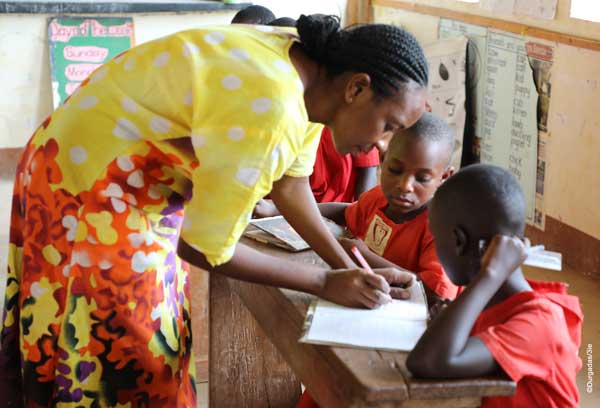More than half of kids in the world are not meeting minimum proficiency levels in reading or math, even though a majority of them of them are already in school, according to UNESCO. This data shows that the issue discussed in last week's blog post—how to get kids into classrooms— is only one part of the problem. So among all the approaches to improve student learning, which are the most reliably effective?
The combination of new instructional materials and teacher training in interventions called ‘structured pedagogy programs’ has consistently raised students' test scores. The combination is likely important: other interventions which only provided new materials did not produce significant effects on student learning.
Programs providing food in schools and merit-based scholarships also seem to help students learn better. More on them below.
This evidence comes from one of 3ie's systematic reviews, which combine the results from numerous studies. This approach provides stronger evidence than relying on a single case, where idiosyncratic issues can affect program outcomes. This particular systematic review analyzed 216 different education programs of various types, including 21 structured pedagogy programs.
These 21 programs came from around the world: 11 in Sub-Saharan Africa, 4 in South Asia, 3 in East Asia, and 3 in Latin America. Most focused on language skills, some on math and a few included both subjects. Interestingly, in some places where structured pedagogy programs only focused on language skills, students' math scores also went up alongside their reading scores.
Exact details of the interventions varied from one place to another, but all included new materials for either teachers or students along with training for teachers on how those particular materials should be used. Most also included some form of follow-up monitoring, mentoring, or feedback for teachers. Regardless of the mix, a vast majority of these interventions raised students' test scores. In contrast, not a single one of the interventions that only included new materials led to a significant improvement in test scores.
 Although evidence for structured pedagogy programs is strongest, two other types of interventions also seem to improve student learning: food in school and merit-based scholarships.
Although evidence for structured pedagogy programs is strongest, two other types of interventions also seem to improve student learning: food in school and merit-based scholarships.
As noted last week, school feeding — where students receive either breakfast, lunch, or a snack at school — is the only type of intervention that consistently increases both attendance and learning. The mechanisms for both effects are clear: food draws students to school, and also helps improve their brain function and attention once they're there.
Research on nutrition and cognition unpacks that. School feeding may supply key nutrients that the brain needs but are lacking in some students' regular diets. Also, children's brains metabolize glucose about twice as rapidly as adults, so regular meals and a continuous glucose supply are more important for their brain function.
As these mechanisms suggest, school feeding programs should only be expected to work in contexts where nutritional deficiencies are common, as was the case in all of the studies included in this review.
These robust findings have led child development experts to call for a focus on school feeding to improve student health and learning. Their call is echoed by the findings from 3ie's systematic review , which found that most of the six school-feeding programs for which data was available led to improved student test scores.
Merit-based scholarships are one other type of intervention that appear to improve student learning. Here, the mechanism is the increased incentive that students have to score well on tests because they might get a scholarship. The nine scholarship programs in the review differed substantially in their rules and the contexts where they were implemented, making it hard to say what design worked best. Nonetheless, the evidence suggests that they are a promising strategy to encourage student learning.
For more information about the study's findings on a whole range of interventions beyond what we've discussed here, as well as its methodology, the full study and a shorter summary are available here. Beyond this study, hundreds of other systematic reviews and thousands of impact evaluations are available in our evidence hub here.
 This is the third blog in our campaign 2020 Hindsight: What works in Development. Learn more about the campaign and read past blogs here.
This is the third blog in our campaign 2020 Hindsight: What works in Development. Learn more about the campaign and read past blogs here.